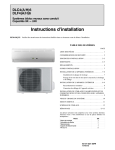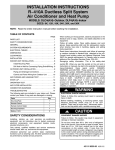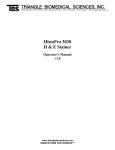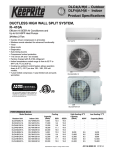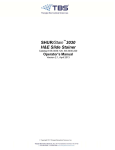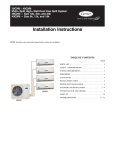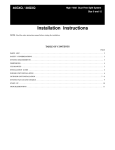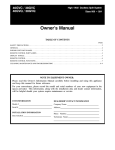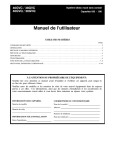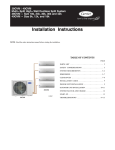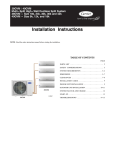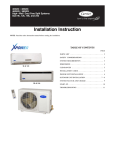Download Carrier 38GVQ Instruction manual
Transcript
40GVC / 38GVC 40GVQ / 38GVQ High---Wall Ductless Split Systems Size 9K --- 36K Installation Instruction NOTE: Read the entire instruction manual before starting the installation. TABLE OF CONTENTS PAGE PARTS LIST . . . . . . . . . . . . . . . . . . . . . . . . . . . . . . . . . . . . . . . 1 SAFETY CONSIDERATIONS . . . . . . . . . . . . . . . . . . . . . . . . . 2 SYSTEM REQUIREMENTS . . . . . . . . . . . . . . . . . . . . . . . . 2--3 DIMENSIONS . . . . . . . . . . . . . . . . . . . . . . . . . . . . . . . . . . . . 4--6 CLEARANCES . . . . . . . . . . . . . . . . . . . . . . . . . . . . . . . . . . . . . 7 INSTALLATION GUIDE . . . . . . . . . . . . . . . . . . . . . . . . . . . . . 8 INDOOR UNIT INSTALLATION . . . . . . . . . . . . . . . . . . . . . 8--9 Install Mounting Plate . . . . . . . . . . . . . . . . . . . . . . . . . . . . . 8 Drill Hole in Wall for Interconnecting Piping, Drain and Wiring . . . . . . . . . . . . . . . . . . . . . . . . . . . . . . . . . . . . . 9 OUTDOOR UNIT INSTALLATION . . . . . . . . . . . . . . . . . . 9--10 Piping Connections . . . . . . . . . . . . . . . . . . . . . . . . . . . . . . . 9 Outdoor Unit Wiring Connections . . . . . . . . . . . . . . . . . . 10 INSTALL ALL POWER, INTERCONNECTING WIRING AND PIPING TO INDOOR UNIT . . . . . . . . . . . . . . . . . . . . . . . . . . 10 SYSTEM VACUUM AND CHARGE . . . . . . . . . . . . . . . . . . . 11 START--UP . . . . . . . . . . . . . . . . . . . . . . . . . . . . . . . . . . . . . . . . 12 WIRING DIAGRAMS . . . . . . . . . . . . . . . . . . . . . . . . . . . . . . . 13 TROUBLESHOOTING . . . . . . . . . . . . . . . . . . . . . . . . . . . 14--17 The following parts are included in your indoor unit. contact your dealer if any parts are damaged or missing: Parts Mounting Plate Mounting Hardware Remote Control Remote Control Holder Battery (1.5V) Qty 1 7 1 1 2 Please SAFETY CONSIDERATIONS Installing, starting up, and servicing air--conditioning equipment can be hazardous due to system pressures, electrical components, and equipment location (roofs, elevated structures, etc.). Only trained, qualified installers and service mechanics should install, start--up, and service this equipment. Untrained personnel can perform basic maintenance functions such as cleaning coils. All other operations should be performed by trained service personnel. When working on the equipment, observe precautions in the literature and on tags, stickers, and labels attached to the equipment. Follow all safety codes. Wear safety glasses and work gloves. Keep quenching cloth and fire extinguisher nearby when brazing. Use care in handling, rigging, and setting bulky equipment. Read these instructions thoroughly and follow all warnings or cautions included in literature and attached to the unit. Consult local building codes and current editions of the National Electrical Code ( NEC ) NFPA 70. In Canada, refer to current editions of the Canadian electrical code CSA 22.1. Recognize safety information. This is the safety--alert symbol !! . When you see this symbol on the unit and in instructions or manuals, be alert to the potential for personal injury.Understand these signal words: DANGER, WARNING, and CAUTION. These words are used with the safety--alert symbol. DANGER identifies the most serious hazards which will result in severe personal injury or death. WARNING signifies hazards which could result in personal injury or death. CAUTION is used to identify unsafe practices which may result in minor personal injury or product and property damage. NOTE is used to highlight suggestions which will result in enhanced installation, reliability, or operation. WARNING ! CAUTION ! EQUIPMENT DAMAGE HAZARD Failure to follow this caution may result in equipment damage or improper operation. Do not bury more than 36 in. (914 mm) of refrigerant pipe in the ground. If any section of pipe is buried, there must be a 6 in. (152 mm) vertical rise to the valve connections on the outdoor units. If more than the recommended length is buried, refrigerant may migrate to the cooler buried section during extended periods of system shutdown. This causes refrigerant slugging and could possibly damage the compressor at start--up. GENERAL These instructions cover the installation, start--up and servicing of 38GVC(Q) outdoor and 40GVC(Q) indoor units duct free systems. SYSTEM REQUIREMENTS Allow sufficient space for airflow and servicing unit. See Fig. 6 for minimum required distances between unit and walls or ceilings. Piping IMPORTANT: Both refrigerant lines must be insulated separately. S Minimum refrigerant line length between the indoor and outdoor units is 10 ft. (3 m). S The following maximum lengths are allowed: Unit Size 9K 12K 18, 24K 30, 36K REFRIGERANT LINE LENGTHS ft. (m) Max Elevation Max Elevation Max Line Length (ID over OD) (OD over ID) 50 (15) 50 (15) 82 (25) 98 (30) 33 (10) 33 (10) 33 (10) 33 (10) 33 (10) 33 (10) 33 (10) 33 (10) S The following are the piping sizes. ELECTRICAL SHOCK HAZARD Unit Size 9, 12K 18, 24K 30, 36K Failure to follow this warning could result in personal injury or death. Before installing, modifying, or servicing system, main electrical disconnect switch must be in the OFF position. There may be more than 1 disconnect switch. Lock out and tag switch with a suitable warning label. PIPE SIZES Mix Phase 1/4” 1/4” 1/4” Vapor 3/8” 1/2” 5/8” Refrigerant Charge Unit Size Charge Amount * LBS (kg) Additional Charge Amount ** oz/ft (g/m) Metering Device *** Cool Only Heat Pump Cool Only Heat Pump Cool Only 9K 2.31 (1.05) 2.31 (1.05) 0.16 (15) 0.16 (15) Capillary 12K 115v 2.54 (1.15) 2.54 (1.15) 0.16 (15) 0.22 (20) Capillary 12K 208/230v 2.2 (1.00) 2.2 (1.0) 0.16 (15) 0.22 (20) Capillary 18K 2.75 (1.25) 2.87 (1.30) 0.16 (15) 0.22 (20) Capillary 24K 3.42 (1.55) 3.42 (1.55) 0.16 (15) 0.22 (20) EXV 30K --- --- --- --5.29 (2.40) --- --- --- --0.54 (50) --- --- --- --36K 5.30 (2.40) 5.73 (2.60) 0.54 (50) 0.54 (50) Capillary * Charge is for piping that runs up to 25 ft. (7.6 m) ** For piping runs greater than 25 ft. (7.6 m), add specified amount of charge per foot of extra piping, up to the allowable length. *** EXV --- Electronic Expansion Device, Capillary tubes are used as metering devices 2 Heat Pump Capillary Capillary Capillary Capillary EXV EXV EXV Connecting (Power and Control Cable) Power Wiring: The main power is supplied to the outdoor unit. The field supplied connecting cable from the outdoor unit to indoor unit consists of three (3) wires and provides the power for the indoor unit. Two wires are high voltage AC power and one is a ground wire. Consult your local building codes and the NEC (National Electrical Code) or CEC (Canadian Electrical Code) for special requirements. All wires must be sized per NEC or CEC and local codes. Use Electrical Data table MCA (minimum circuit amps) and MOCP (maximum over current protection) to correctly size the wires and the disconnect fuse or breakers respectively. Per caution note, only copper conductors with a minimum 300 volt rating and 2/64--inch thick insulation must be used. ! EQUIPMENT DAMAGE HAZARD Failure to follow this caution may result in equipment damage or improper operation. S Wires should be sized based on NEC and local codes. S Use copper conductors only with a minimum 300 volt . rating and 2/64 inch thick insulation. ! 18 AWG 16 AWG CAUTION EQUIPMENT DAMAGE HAZARD Failure to follow this caution may result in equipment damage or improper operation. Control Wiring: A separate shielded copper conductor only, with a minimum 300 volt rating and 2/64--inch thick insulation, must be used as the communication wire from from the outdoor unit to the indoor unit. To minimize voltage drop of the control wire, use the following wire size and maximum lengths shown in the chart below. Wire Size CAUTION S Be sure to comply with local codes while running wire from indoor unit to outdoor unit. S Every wire must be connected firmly. Loose wiring may cause terminal to overheat or result in unit malfunction. A fire hazard may also exist. Therefore, be sure all wiring is tightly connected. Length ft (m) 50 ft. (15 m) 50 ft (15) to 100 ft. (30 m) S No wire should be allowed to touch refrigerant tubing, compressor or any moving parts. S Disconnecting means must be provided and shall be located within sight and readily accessible from the air conditioner. S Connecting cable with conduit shall be routed through hole in the conduit panel. Electrical Data Unit Size System Voltage Volts--- Ph.--- Freq. Operating Voltage (Min/Max) Compressor RLA LRA Outdoor Fan Indoor Fan Volts FLA Output Watts Volts FLA Output Watts MCA Max Fuse/CB Amps (MOCP) 9K--- AC 115--- 1--- 60 103/127 9.76 25 115 AC 0.17 30 115 V--- AC 0.38 15.0 13 20 9K--- HP 115--- 1--- 60 103/127 9.76 20 176--- 375 DC 0.17 30 115 V--- AC 0.38 15.0 13 20 12K--- AC 115--- 1--- 60 103/127 11.20 25 115 AC 0.17 30 115 V--- AC 0.38 15.0 15 25 12K--- HP 115--- 1--- 60 103/127 11.20 20 176--- 375 DC 0.17 30 115 V--- AC 0.38 15.0 15 25 12K 208/230--- 1--- 60 187/253 7.30 16.5 208/230 AC 0.25 21 208/230 V--- AC 0.19 15.0 10 15 18K 208/230--- 1--- 60 187/253 10.86 27 208/230 AC 0.62 60 208/230 V--- AC 0.32 20.0 15 25 24K 208/230--- 1--- 60 187/253 11.71 41 208/230 AC 0.62 60 208/230 V--- AC 0.45 35.0 16 25 30K 208/230--- 1--- 60 187/253 13.45 40 310 DC 0.45 100 208/230 V--- AC 0.40 40.0 20 30 36K--- AC 208/230--- 1--- 60 187/253 16.92 67 310 DC 0.73 100 208/230 V--- AC 0.47 60.0 24 35 36K--- HP 208/230--- 1--- 60 187/253 17.50 67 310 DC 0.73 170 208/230 V--- AC 0.47 60.0 24 40 3 DIMENSIONS -- INDOOR W D H A12377 Unit Size 9K 12K 18K 24K 30/36 K W In. (mm) 30.3 (770) 30.3 (770) 34.0 (865) 39.7 (1008) 53.1 (1349) H In. (mm) 11.1 (283) 11.1 (283) 12.0 (305) 12.6 (319) 12.8 (325) D In. (mm) 7.9 (201) 7.9 (201) 8.5 (215) 8.7 (221) 10.0 (254) Net Operating Weight Lbs. (Kg) 18.7 (8.5) 19.8 (9.0) 26.5 (12.0) 33.1 (15.0) 44.1 (20.0) Fig. 1 --- Indoor Unit Dimensions DIMENSIONS - OUTDOOR 10.1 (257) 21.3 (540) 30.0 (762) 12.6 (320) 33.4 (848) 11.7 (267) Unit: IN. (mm) 21.3 (540) Fig. 2 --- 9K and 12K 115V (Net Operating Weight: 75 lbs. / 34 kg) 4 A12531 DIMENSIONS - OUTDOOR CONTINUED 25.9 (658) 21.7 (551) 10.8 (274) 28.0 (711) 12.5 (318) 18.5 (470) Unit: IN. (mm) 11.8 (300) Unit: IN. (mm) A12532 Fig. 3 --- 12K 230V (Net Operating Weight: 63.8 lbs. / 30 kg) 35.0 (890) 27.6 (700) 13.4 (340) 37.9 (963) 15.6 (396) 22.0 (560) 14.3 (364) Unit: IN. (mm) Fig. 4 --- 18K and 24K (Net Operating Weight: 112.2 lbs. / 51 kg) 5 A12533 DIMENSIONS - OUTDOOR CONTINUED 36 (914.4) 14.6 (370.8) 31.1 (789.9) 16.7 (424.2) 38.6 (980.4) 24 (609.6) 15.7 (398.8) in. (mm) Fig. 5 --- 30K and 36K (Net Operating Weight: 30K = 154 lbs. / 70 kg; 36K = 161 lbs. / 73 kg) 6 A12379 CLEARANCES Indoor Unit Distance to Ceiling 6 in (152 mm) Distance to Wall 6 in (152 mm) Distance to Wall 6 in (152 mm) Distance in Front of Unit 118 in (2997 mm) Distance to Floor 66 in (1676 mm) NOTE: Refrigerant lines may be routed in any of the (4) directions, right, right rear, left, or left rear. See instructions for details ● The clearance dimensions are necessary for a correct installation and are the minimum permissible distances to adjacent structures. Outdoor Unit Above Unit 20 in (508 mm) Air Inlet Side 12 in (305 mm) Distance to Back Wall 12 in (305 mm) Distance to Wall 20 in (508 mm) Air Discharge Side 79 in (2007 mm) valve cover A12385 Fig. 6 --- Indoor and Outdoor Unit Clearances 7 INSTALLATION GUIDE 30.3 (770) 10.2 (258.5) Unit: IN. (mm) A12534 Fig. 7 --- 09 and 12K Mounting Plate Spacing 34.1 (865) 6.9 (175) 5.9 (150) 21.3 (540) Φ55 Φ55 1.6 (40) 1.6 (40) Unit: IN. (mm) A12535 Fig. 8 --- 18k Mounting Plate Spacing 39.7 (1008) 27.0 (685) 5.1 (130) 7.6 (193) Φ55 12.6 (319) INDOOR UNIT INSTALLATION INSTALL MOUNTING PLATE 1. Carefully remove the mounting plate from the unit box. 2. The mounting plate should be located horizontally and level on the wall. All minimum spacings shown in Fig. 7 through Fig. 10 should be maintained. 3. If the wall is block, brick, concrete or similar material, drill .2” (5 mm) diameter holes and insert anchors for the appropriate mounting screws. 4. Attach the mounting plate to the wall. 21.6 (548.5) 50 (126.5) 11.1 (283) Ideal installation locations include: Indoor Unit S A location where there are no obstacles near inlet and outlet area. S A location which can bear the weight of indoor unit. S Do not install indoor units near a direct source of heat such as direct sunlight or a heating appliance. S A location which provides appropriate clearances as outlined in Fig. 6. Be sure to leave enough distance to allow access for routine maintenance. The installation site should be 66 in (1676 mm) or more above the floor. S Select a place away from potential electronic interference. S Select a place where the filter can be easily removed. Outdoor Unit S A location which is convenient to installation and not exposed to strong wind. S A location which can bear the weight of outdoor unit and where the outdoor unit can be mounted in a level position. S A location which provides appropriate clearances as outlined in Fig. 6. S Do not install the indoor or outdoor units in a location with special environmental conditions. S Make sure the outdoor unit is installed in accordance with the installation instructions and is convenient for maintenance and repair. S See the refrigerant piping table for the maximum height difference between indoor and outdoor units and the maximum length of the connecting tubing. Φ55 2.0 (50) 2.0 (50) 3.9 (100) Unit: IN. (mm) 4.9 (124) Fig. 9 --- 24k Mounting Plate Spacing 10.0 (254.0) A12536 13.7 (348.0) 29.4 (746.8) Unit: IN. (mm) Fig. 10 --- 30/36k Mounting Plate Spacing Wall Wall Mark middle Level 6 in. See Hole Size Tables 6 in. (Rear piping hole) (Rear piping hole) Fig. 11 --- Mounting Plate Spacing 8 See Hole Size Tables A12537 A12584 DRILL HOLE IN WALL FOR INTERCONNECTING PIPING, DRAIN AND WIRING OUTDOOR UNIT INSTALLATION 1. Use a rigid base to support unit in a level position. 2. Locate outdoor unit and connect piping and wiring. Refrigerant Line Routing The refrigerant lines may be routed in any of the four directions shown in Fig. 12. For maximum serviceability, it is recommended to have refrigerant line flare connections and the drain connection on the outside of the wall that the fan coil is mounted on. ! CAUTION EQUIPMENT DAMAGE HAZARD Failure to follow this caution may result in equipment damage or improper operation. Excessive torque can break flare nut depending on installation conditions. As viewed from front Knockout 3 (030, 036 only) Knockout 2 3 1 Right Exit 2 Right Rear Exit (a) 4 Knockout 1 Left Exit Left Rear Exit (b) (c) Fig. 12 --- Refrigerant Line Routing A12585 If piping is going through the back: 1. Determine pipe hole position using the mounting plate as a template. Drill pipe hole diameter per chart below. The outside pipe hole is 1/2--in. (13 mm) min. lower than inside pipe hole, so it slants slightly downward (see Fig. 13). If piping is going to exit from the left rear, it is recommended to field--fabricate piping extensions to get the flare connections to the outside of the wall. 1/2 in. (13 mm) Min. INDOOR OUTDOOR A07371 Model Size 9k, 12k and 18k 24k, 30k, 36k Hole Diameter in. (mm) 2.2 (56) 2.8 (71) Fig. 13 --- Drill Holes Piping Connections to Outdoor Unit IMPORTANT: Use refrigeration grade tubing ONLY. No other type of tubing may be used. Use of other types of tubing will void manufacturer’s warranty. Make sure there is enough piping to cover the required length between the outdoor and indoor unit. Only use piping suitable for high side pressure for both high side and low side connections. Piping Guide: S Do not open service valves or remove protective caps from tubing ends until all the connections are made. S Bend tubing with bending tools to avoid kinks and flat spots. S Keep the tubing free of dirt, sand, moisture, and other contaminants to avoid damaging the refrigerant system. S Avoid sags in the suction line to prevent the formation of oil traps. Insulate each tube with minimum 3/8--in. (10 mm) wall thermal pipe insulation. Inserting the tubing into the insulation before making the connections will save time and improve installation quality. 1. Remove service valve cover if provided with unit. 2. Cut tubing with tubing cutter. 3. Install correct size flare nut onto tubing and make flare connection. 4. Apply a small amount of refrigerant oil to the flare connection on the tubing. 5. Properly align tubing in with service valve. 6. Tighten flare nut and finish installation using two wrenches as shown in Fig. 14. If piping is going through the right or left side: 1. Use a small saw blade to carefully remove the corresponding plastic covering on side panel and drill the appropriate size hole where the pipe is going through the wall. See Fig. 19. 2. Remove knockout 1 to run just the wiring. Remove knockout 1 and 2 or knockout 1, 2 and 3 if you are running both piping and wiring through the side of the unit. See Fig. 12. NOTE: If required, a condensate pump is available for the application. Fig. 14 --- Tighten Flare Nut A07354 Strong wind Fig. 15 --- High Wind Installation 9 A07350 Outdoor Unit Wiring Connections 1. Mount outdoor power disconnect. 2. Run power wiring from main box to disconnect per NEC and local codes. Set outdoor unit in place. 3. Remove field wiring cover from unit by removing screws. 4. Connect conduit to the conduit panel. (See Fig. 16) 5. Properly connect both power supply and control lines to terminal block per the connection diagram. 6. Ground unit in accordance with NEC and local electrical codes. 7. Use lock nuts to secure conduit. 8. Reinstall field wiring cover. Fig. 17 --- Hanging Indoor Unit 5. Open front cover of indoor unit and remove field wiring terminal block cover (see Fig. 18) Field Wiring Cover Field Wiring Cover Interconnecting Cable Conduit Panel Fig. 18 --- Field Wiring Cover lock nut conduit Finish Fig. 16 --- Field Wiring ! A12539 CAUTION EQUIPMENT DAMAGE HAZARD Failure to follow this caution may result in equipment damage or improper operation. S Be sure to comply with local codes while running wire from indoor unit to outdoor unit. S Every wire must be connected firmly. Loose wiring may cause terminal to overheat or result in unit malfunction. A fire hazard may also exist. Therefore, be sure all wiring is tightly connected. S No wire should be allowed to touch refrigerant tubing, compressor or any moving parts. S Disconnecting means must be provided and shall be located within sight and readily accessible from the air conditioner. S Connecting cable with conduit shall be routed through hole in the conduit panel. A08283 A08279 6. Pull interconnecting wire up from back of indoor unit and position in close to the terminal block on indoor unit. 7. Push bottom of indoor unit onto mounting plate to complete wall mount. 8. Connect wiring from outdoor unit per connection diagram (see Fig. 26). NOTE: Polarity of power wires must match original connection on outdoor unit. 9. Replace field wiring cover and close front cover of indoor unit. 10. Connect refrigerant piping and drain line outside of indoor unit. Refer to Fig. 14 for proper installation of flare connections. Complete pipe insulation at flare connection then fasten piping and wiring to the wall as required. Completely seal the hole in the wall. Knockout 3 (030, 036 Only) Knockout 2 Knockout 1 Fig. 19 --- Remove Knockouts Fixing hook INSTALL ALL POWER, INTERCONNECTING WIRING, AND PIPING TO INDOOR UNIT. Mounting 1. Run interconnecting piping and wiring from outdoor unit to indoor unit. 2. Pass interconnecting cable through hole in wall (outside to inside). 3. Lift indoor unit into position and route piping and drain through hole in wall (inside to outside). Fit interconnecting wiring into back side of indoor unit. 4. Hang indoor unit on upper hooks of wall mounting plate (as shown in Fig. 17 and Fig. 20) A12540 Mounting plate plate Fig. 20 --- Hang Indoor Unit 10 A12408 CAUTION ! UNIT DAMAGE HAZARD Failure to follow this caution may result in equipment damage or improper operation. Deep Vacuum Method The deep vacuum method requires a vacuum pump capable of pulling a vacuum of 500 microns and a vacuum gage capable of accurately measuring this vacuum depth. The deep vacuum method is the most positive way of assuring a system is free of air and liquid water. (See Fig. 23) 5000 4500 4000 3500 3000 2500 2000 1500 1000 500 Never use the system compressor as a vacuum pump. SYSTEM VACUUM AND CHARGE Using Vacuum Pump 1. Completely tighten flare nuts A, B, C, D, connect manifold gage charge hose to a charge port of the low side service valve. (See Fig. 21.) 2. Connect charge hose to vacuum pump. 3. Fully open the low side of manifold gage. (See Fig. 22) 4. Start vacuum pump 5. Evacuate using either deep vacuum or triple evacuation method. 6. After evacuation is complete, fully close the low side of manifold gage and stop operation of vacuum pump. 7. The factory charge contained in the outdoor unit is good for up to 25 ft. (8 m) of line length. For refrigerant lines longer than 25 ft (8 m), add 0.1 oz. per foot of extra piping up to the maximum allowable length. 8. Disconnect charge hose from charge connection of the low side service valve. 9. Fully open service valves B and A. 10. Securely tighten caps of service valves. Indoor Unit Refrigerant Outdoor Unit A Low Side B High Side C D LEAK IN SYSTEM MICRONS Refrigerant tubes and indoor coil should be evacuated using the recommended deep vacuum method of 500 microns. The alternate triple evacuation method may be used if the procedure outlined below is followed. Always break a vacuum with dry nitrogen. VACUUM TIGHT TOO WET TIGHT DRY SYSTEM 0 1 2 3 4 5 MINUTES 6 7 Fig. 23 --- Deep Vacuum Graph A95424 Triple Evacuation Method The triple evacuation method should only be used when vacuum pump is only capable of pumping down to 28 in. of mercury vacuum and system does not contain any liquid water. Refer to Fig. 24 and proceed as follows: 1. Pump system down to 28 in. of mercury and allow pump to continue operating for an additional 15 minutes. 2. Close service valves and shut off vacuum pump. 3. Connect a nitrogen cylinder and regulator to system and open until system pressure is 2 psig. 4. Close service valve and allow system to stand for 1 hr. During this time, dry nitrogen will be able to diffuse throughout the system absorbing moisture. 5. Repeat this procedure as indicated in Fig. 24. System will then be free of any contaminants and water vapor. EVACUATE Service Valve A07360 Fig. 21 --- Service Valve BREAK VACUUM WITH DRY NITROGEN WAIT Manifold Gage EVACUATE BREAK VACUUM WITH DRY NITROGEN 500 microns Low side valve Charge hose WAIT High side valve EVACUATE Charge hose CHECK FOR TIGHT, DRY SYSTEM (IF IT HOLDS DEEP VACUUM) Vacuum pump RELEASE CHARGE INTO SYSTEM Low side valve Fig. 22 --- Manifold Fig. 24 --- Triple Evacuation Method A07361 A95425 Final Tubing Check IMPORTANT: Check to be certain factory tubing on both indoor and outdoor unit has not shifted during shipment. Ensure tubes are not rubbing against each other or any sheet metal. Pay close attention to feeder tubes, making sure wire ties on feeder tubes are secure and tight. 11 START--UP Test Operation Perform test operation after completing gas leak and electrical safety check. 1. Push the “ON/OFF” button on Remote Control to begin testing. NOTE: A protection feature prevents the air conditioner from being activated for approximately 3 minutes. 2. Push MODE button, select COOLING, HEATING, FAN mode to check if all functions work correctly. INSTALLATION AND MAINTENANCE OF FILTER 1. Grasp the front panel by it’s two ends and lift the panel and then remove the air filter. 2. Install a clean air filter along the arrow direction and close the panel. SYSTEM CHECKS 1. Conceal the tubing where possible. 2. Make sure that the drain tube slopes downward along its entire length. 3. Ensure all tubing and connections are properly insulated. 4. Fasten tubes to the outside wall, when possible. 5. Seal the hole through which the cables and tubing pass. INDOOR UNIT 1. 2. 3. 4. Do all Remote Control buttons function properly? Do the display panel lights work properly? Does the air deflection louver function properly? Does the drain work? Air filter OUTDOOR UNIT 1. Are there unusual noises or vibrations during operation? Explain Following Items To Customer With The Aid Of The Owner’s Manual: 1. How to turn air conditioner on and off; selecting COOLING, HEATING and other operating modes; setting a desired temperature; setting the timer to automatically start and stop air conditioner operation; and all other features of the Remote Control and display panel. 2. How to remove and clean the air filter. 3. How to set air deflection louver. 4. Explain care and maintenance. 5. Present the Owner’s Manual and installation instructions to customer. Auxiliary filter Fig. 25 --- Install Air Filter 12 A12541 WIRING DIAGRAMS 38GV/40GV 9K~12K 115-1-60 Connection Diagram CONNECTING CABLE OUTDOOR TO INDOOR N S L L N Pow er to Control Pow er to Indoor to Indoor Indoor Unit Unit Unit Main Pow er Supply Main Pow er Supply 115-1-60 Low V DC 115-1-60 115-1-60 115-1-60 GND N S L GND Ground Pow er from Outdoor Unit Control from Outdoor Unit Pow er from Outdoor Unit Ground 115-1-60 Low V DC 115-1-60 38GV 9K~12K Outdoor Unit Terminal Block 40GV 9K~12K Indoor Unit Terminal Block 38GV/40GV 12K 208/230-1-60 Connection Diagram CONNECTING CABLE OUTDOOR TO INDOOR L2 S Pow er to Indoor Unit L1 GND Control Pow er to to Indoor Indoor Unit Unit L2 S Ground 208/230-1-60 Low V DC 208/230-1-60 208/230-1-60 L2 L1 GND Main Pow er Supply Main Pow er Supply Ground 208/230-1-60 208/230-1-60 L1 GND Control Pow er from Pow er from from Outdoor Unit Outdoor Unit Ground Outdoor Unit Low V DC 208/230-1-60 40GV 12K Indoor Unit Terminal Block 38GV 12K Outdoor Unit Terminal Block 38GV/40GV 18K~36K 208/230-1-60 Connection Diagram CONNECTING CABLE OUTDOOR TO INDOOR L2 Pow er to Indoor Unit S Control to Indoor Unit 208/230-1-60 Low V DC L1 Pow er to Indoor Unit L1 L2 Main Pow er Main Pow er Supply Supply GND Ground 208/230-1-60 208/230-1-60 208/230-1-60 L2 S L1 GND Pow er from Outdoor Unit Control from Outdoor Unit Pow er from Outdoor Unit Ground 208/230-1-60 Low V DC 208/230-1-60 38GV 18K~36K Outdoor Unit Terminal Block 40GV 18K~36K Indoor Unit Terminal Block NOTE: Polarity of power wires must match original connection on outdoor unit. Fig. 26 --- Unit Wiring Diagrams 13 A12542 TROUBLESHOOTING This unit has on--board diagnostics. Error codes will appear on the LED display on the front panel of the indoor unit in place of the temperature display. Error codes are also displayed on the outdoor unit microprocessor board with colored LED lights. The table below explains the error codes for both units. Diagnostic Codes 38/40GVC/Q 9k / 12k, 115v Malfunction Error Code on indoor unit Repair Method/Cause Indoor PCB Malfunction EE Replace indoor main board Anti--- freeze Protection E2 Outdoor ambient temperature is too low System overload protection H4 Check for dirty or blocked heat exchangers Indoor motor malfunction H6 Check motor mounting and wiring Indoor pipe temperature sensor malfunction F2 Measure the resistance value in the sensor Return air temperature sensor malfunction F1 Measure the resistance value in the sensor Indoor board malfunction UF Replace indoor main board Compressor overload protection H3 Check overload wiring Compressor start--- up failure Lc Check if the resistance of the compressor and the resistance to ground is normal. If the resistance is normal, the outdoor main board may be defective. Outdoor fan motor failure UH Check outdoor motor Low voltage protection E5 Check incoming power 4--- way valve malfunction U7 Replace 4--- way valve Compressor phase detection error U1 Replace outdoor main board Compressor speed reduction H7 Check if the resistance of the compressor and the resistance to ground is normal. If the resistance is normal, the outdoor main board may be defective. Current detection malfunction U5 Replace outdoor main board Outdoor ambient temperature sensor malfunction F3 Measure the resistance value in the sensor Discharge temperature sensor malfunction (out of range) E4 Measure the resistance value in the sensor Discharge temperature sensor malfunction (open or shorted) F5 Measure the resistance value in the sensor Condenser temperature sensor malfunction (open or shorted) F4 Measure the resistance value in the sensor Heat sink over--- temperature P8 Is outdoor ambient temperature out of system operating range? Is heat sink blocked or damaged? DC over--- current UU --- --- Heat sink temperature sensor malfunction P7 Replace outdoor main board Low charge F0 Check for leaks DC input voltage is too high PH Check incoming power supply DC input voltage is too low PL Check incoming power supply Communication malfunction E6 Check wiring connection Indoor and outdoor unit mismatched UA Check system combination 14 TROUBLESHOOTING (CONTINUED) Diagnostic Codes 38/40GVC/Q 12K, 230v Malfunction Error Code on indoor unit Repair Method/Cause Indoor PCB Malfunction EE Replace indoor main board Anti--- freeze Protection E2 Outdoor ambient temperature is too low System overload protection H4 Check for dirty or blocked heat exchangers Indoor motor malfunction H6 Check motor mounting and wiring Indoor pipe temperature sensor malfunction F2 Measure the resistance value in the sensor Return air temperature sensor malfunction F1 Measure the resistance value in the sensor Indoor board malfunction UF Replace indoor main board Compressor overload protection H3 Check overload wiring Compressor start--- up failure Lc Check if the resistance of the compressor and the resistance to ground is normal. If the resistance is normal, the outdoor main board may be defective. Outdoor fan motor failure UH Check outdoor motor Low voltage protection E5 Check incoming power 4--- way valve malfunction U7 Replace 4--- way valve Compressor phase detection error U1 Replace outdoor main board Compressor speed reduction H7 Check if the resistance of the compressor and the resistance to ground is normal. If the resistance is normal, the outdoor main board may be defective. Current detection malfunction U5 Replace outdoor main board Outdoor ambient temperature sensor malfunction F3 Measure the resistance value in the sensor Discharge temperature sensor malfunction (out of range) E4 Measure the resistance value in the sensor Discharge temperature sensor malfunction (open or shorted) F5 Measure the resistance value in the sensor Condenser temperature sensor malfunction (open or shorted) F4 Measure the resistance value in the sensor Heat sink over temperature P8 Is outdoor ambient temperature out of system operating range? Is heat sink blocked or damaged? DC over--- current H5 --- --- Heat sink temperature sensor malfunction P7 Replace outdoor main board Low charge F0 Check for leaks DC input voltage is too high PH Check incoming power supply DC input voltage is too low PL Check incoming power supply Communication malfunction E6 Check wiring connection Indoor and outdoor unit mismatched UA Check system combination 15 TROUBLESHOOTING (CONTINUED) Diagnostic Codes 38/40GVC/Q 18k--24k, 230v Error Code on indoor unit Repair Method/Cause System high pressure protection E1 Poor heat exchange. Are the coils clogged or blocked? Is the ambient temperature out of system range? Anti--- freeze Protection E2 Outdoor ambient temperature is too low Discharge temperature sensor malfunction (out of range) E4 Measure the resistance value in the sensor Low voltage protection E5 Check incoming power Communication malfunction E6 Check wiring connection System overload protection E8 Refer to Service Manual Indoor board malfunction U8 Replace indoor main board Indoor motor malfunction H6 Check motor mounting and wiring Missing jumper from indoor board C5 No jumper on controller or installed improperly or damaged. Corresponding circuit on main board has malfunction. Return air temperature sensor malfunction F1 Measure the resistance value in the sensor Indoor pipe temperature sensor malfunction F2 Measure the resistance value in the sensor Outdoor ambient temperature sensor malfunction F3 Measure the resistance value in the sensor Condenser temperature sensor malfunction (open or shorted) F4 Measure the resistance value in the sensor Discharge temperature sensor malfunction (open or shorted) F5 Measure the resistance value in the sensor Overload limit, compressor speed reduction F6 Refer to Service Manual Over current compressor speed reduction F8 System voltage is too low or system voltage is high Compressor discharge temperature high, compressor speed reduction F9 Load is too great Ambient temperature too high Refrigerant is low Electric expansion valve malfunction Over voltage protection PH Check incoming power supply Current detection malfunction U5 Replace outdoor main board Compressor current protection P5 Refer to Service Manual. Check inverter board. Defrosting H1 H1 signal normal operation Compressor overload protection H3 Check overload wiring System overload protection H4 Checked for dirty or blocked heat exchangers IPM protection H5 IPM module over temperature, low voltage, silica grease problem PFC (power factor correction) board protection HC Refer to Service Manual Compressor speed reduction H7 Check if the resistance of the compressor and the resistance to ground is normal. If the resistance is normal, the outdoor main board may be defective. Ambient temperature cut off range H0 Refer to Service Manual (overload, high temperature, cutout) Compressor start--- up failure LC Check if the resistance of the compressor and the resistance to ground is normal. If the resistance is normal, the outdoor main board may be defective. Compressor phase detection error U1 Replace outdoor main board Malfunction 16 TROUBLESHOOTING (CONTINUED) Diagnostic Codes 38/40GVC/Q 30k--36k, 230v Malfunction Error Code on indoor unit Repair Method/Cause Defrosting H1 H1 signal normal operation Anti--- freeze Protection E2 Outdoor ambient temperature is too low IPM protection H5 IPM module over temperature, low voltage, silica grease problem Low voltage protection E5 Check incoming power System overload protection H4 Checked for dirty or blocked heat exchangers Discharge temperature sensor malfunction (out of range) E4 Measure the resistance value in the sensor Compressor overload protection H3 Check overload wiring, compressor shell overheat, low charge Compressor high voltage/power protection L9 Compressor voltage too high, ambient temperature out of range IPM protection H5 IPM module over temperature, low voltage, silica grease problem Indoor PCB Malfunction EE Replace main indoor board DC input voltage is too low PL Check incoming power supply DC input voltage is too high PH Check incoming power supply PFC (power factor correction) board protection HC Refer to Service Manual Indoor motor malfunction H6 Check motor mounting and wiring Indoor and outdoor units mismatched LP Check system combination Condenser temperature sensor malfunction (open or shorted) F4 Measure the resistance value in the sensor Outdoor ambient temperature sensor malfunction F3 Measure the resistance value in the sensor Discharge temperature sensor malfunction (open or shorted) F5 Measure the resistance value in the sensor Return air temperature sensor malfunction F1 Measure the resistance value in the sensor Indoor pipe temperature sensor malfunction F2 Measure the resistance value in the sensor Communication malfunction E6 Check wiring connection Missing jumper from indoor board C5 No jumper on controller or installed improperly or damaged. Corresponding circuit on main board has malfunction. System high pressure protection E1 Poor heat exchange. Are the coils clogged or blocked? Is the ambient temperature out of system range? 17 Copyright 2013 Carrier Corp. S 7310 W. Morris St. S Indianapolis, IN 46231 Edition Date: 07/13 Manufacturer reserves the right to change, at any time, specifications and designs without notice and without obligations. 18 Catalog No: 38---40GVC ---Q---2SI Replaces: 38--- 40GVC--- Q--- 1SI



















